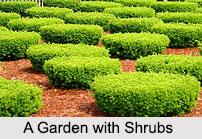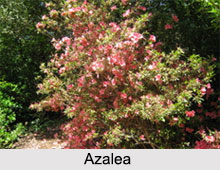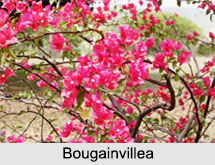 Indian shrubs are semi-woody or woody perennial plants. They are of various kinds and they attach diversity to the flora of the nation. The best small Indian shrubs generally have flowers and attractive leaves in spring or summer seasons. In autumn, the shrubs produce berries in red, yellow or gold. Some of the Indian shrubs are little prostrate, that are considered to be excellent ground flowers. Usually the branches of the shrubs arise from the base, growing up to 3 to 4 m in height. Flowers alone are not enough to make a great garden, thus shrubs fill up the empty spaces, completing the look of the garden. Several small shrubs, mainly those with flowers like lilacs, hydrangeas and crab-apples are regarded as the spine of the landscape, similar to trees. Indian shrubs create a composite picture of gardens in the country.
Indian shrubs are semi-woody or woody perennial plants. They are of various kinds and they attach diversity to the flora of the nation. The best small Indian shrubs generally have flowers and attractive leaves in spring or summer seasons. In autumn, the shrubs produce berries in red, yellow or gold. Some of the Indian shrubs are little prostrate, that are considered to be excellent ground flowers. Usually the branches of the shrubs arise from the base, growing up to 3 to 4 m in height. Flowers alone are not enough to make a great garden, thus shrubs fill up the empty spaces, completing the look of the garden. Several small shrubs, mainly those with flowers like lilacs, hydrangeas and crab-apples are regarded as the spine of the landscape, similar to trees. Indian shrubs create a composite picture of gardens in the country.
Types of Indian Shrubs
 Indian shrubs exist in a wide range of colors, shapes, sizes and adaptability. The shrubs can be either evergreen or deciduous. There are foliage shrubs with very attractive leaves. Some of the most common Indian shrubs are red bell bush, golden shower, purple wreath, moonbeam, poinsettia, yellow oleander, brilliant gardenia, gardenia, hibiscus shrub, ixora shrub, golden dewdrops, peacock flower, golden champak, rangoon creeper, railway creeper, allamanda, camphire shrub and lantana shrub. Some of the popular Indian shrubs are azalea, buddleia, camelia, gardenia and hydrangea. Some of the Indian shrubs make attractive standards like bougainvillea, byra and hibiscus.
Indian shrubs exist in a wide range of colors, shapes, sizes and adaptability. The shrubs can be either evergreen or deciduous. There are foliage shrubs with very attractive leaves. Some of the most common Indian shrubs are red bell bush, golden shower, purple wreath, moonbeam, poinsettia, yellow oleander, brilliant gardenia, gardenia, hibiscus shrub, ixora shrub, golden dewdrops, peacock flower, golden champak, rangoon creeper, railway creeper, allamanda, camphire shrub and lantana shrub. Some of the popular Indian shrubs are azalea, buddleia, camelia, gardenia and hydrangea. Some of the Indian shrubs make attractive standards like bougainvillea, byra and hibiscus.
Essential Conditions for the Growth of Indian Shrubs
 Indian shrubs generally grow in almost all types of soil found in the country. Moisture, soil and sunlight requirements of the chosen shrub should match the conditions in the yard. For example, woody plants which grow best in moist conditions will grow poorly in dry soil areas, if they are not watered.
Indian shrubs generally grow in almost all types of soil found in the country. Moisture, soil and sunlight requirements of the chosen shrub should match the conditions in the yard. For example, woody plants which grow best in moist conditions will grow poorly in dry soil areas, if they are not watered.
Suitable Arrangements for the Growth of Indian Shrubs
A shrub, like a tree, may be grown as a focus of attention in a lawn or rockery, surrounded by a mass of annuals, or in herbaceous border. Shrubs may be grown collectively in a corner called the shrubbery or the shrub border. A carpet annual like Tagetes Signata Pumila or Mesembryanthemum is grown as a border of the shrubbery. An evergreen low creeping plant like Pilea Mucosa grows under a shrub. Shrubs like azaleas and rhododendron can be grown in a mass for grand effect. Lilies and other bulbous plants can also be grown intermixed with shrubs.
Currently, the popular trend is not to separate flowers in their own garden beds, but to plant a mixed border. Small flowering trees and shrubs are planted along with flowers. This arrangement is visually pleasing in all the seasons. It is important to note that trees and shrubs do not need much maintenance, if chosen carefully. They can be the easiest-care plants.











